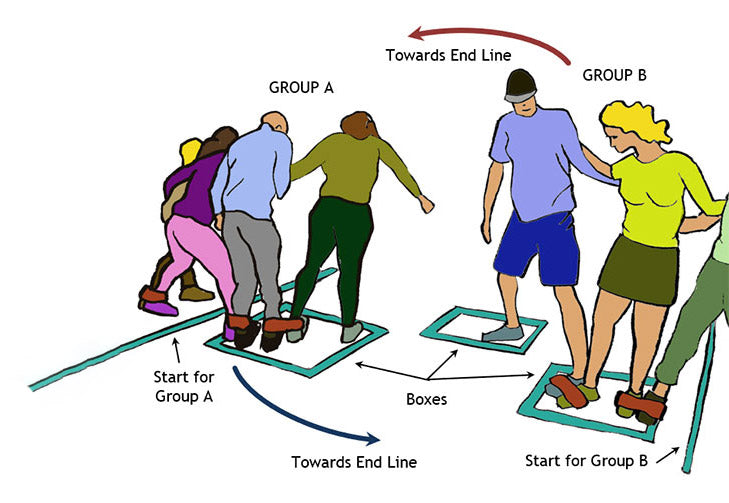Purpose
The purpose of this exercise is to show that each person in a team has certain characteristics that can contribute to the team. It is not necessarily about casting each person into an ideal team member role; instead, it is about taking advantage of each person’s unique strengths.
The exercise uses a visual technique—a clock that represents four types of personalities; hence, Clock Types exercise.
This exercise is ideal for team building, management, enhancing communication skills and coaching.
Objective
Learn about four personality types and use this knowledge to communicate more effectively.
What You Need
- A rope, six meters long.
- Four large cards A4 or A3 size with the following written on each. An example set is shown in the image above. The numbers represent clock hour:
- 3: Let’s think about it.
- 6: Let’s do it.
- 9: Let’s consider the feelings.
- 12: Let’s pay attention to detail.
Setup
- Prepare the scene for the exercise by placing a rope on the floor in the shape of a circle, with a diameter of about 2 m. This forms the face of your clock. Place the cards at the correct locations based on clock hours.
- Explain that there are four types of people. Each is represented at a certain clock hour. Delegates must examine all four types and then decide which one represents them the most.
- To make decision making easier explain the following and show them in a slide for reference:
- 3: Let’s think about it.
- Look at the big picture, birds eye view, possibilities.
- 6: Let’s do it.
- Focus on actions, plunge in, use momentum, energy and excitement to get things done.
- 9: Let’s consider the feelings.
- Consider people’s feeling, how they will be affected, what their thoughts and needs are.
- 12: Let’s pay attention to detail.
- Think it through, plan systematically, examine all parameters and optimise.
- 3: Let’s think about it.
- Once delegates have become familiar with the four categories, get them to choose one that represents them best and ask them to stand next to the card on the floor. This will divide the delegates into four groups.
Stage 1:
- Ask each group to consider two questions:
- What are the strengths of your type?
- What are the weaknesses of your type?
- Allocate 5 minutes.
- Bring everyone’s attention back while standing where they are. Ask each group to present their thoughts. This discussion helps to prepare the delegates for the next stage.
Stage 2:
- Ask delegates to consider two more questions:
- Which other type do they find most difficult to work with?
- Which other type do they find most easy to work with?
- Allocate 5 minutes.
- As before, bring everyone’s attention back and ask each group to present their thoughts.
Stage 3:
- Ask delegates to consider two more questions:
- Given your type, what is one characteristic you value in each of the other types?
- Given your type, what others need to know about you so that you can work together more effectively?
- Allocate 5 minutes.
- As before, bring everyone’s attention back and ask each group to present their thoughts.
- Here, the discussion can become valuable as differences in types are highlighted. It would shed light on why people might have difficulty communicating with each other at work. Here are some examples:
- Which types get frustrated with attention-oriented type?
- Which types get frustrated with those who want to jump in and do it right away?
- What happens when feelings (of co-workers, customers, suppliers, etc.) are not considered?
- Follow with a discussion.
Timing
Explaining the Exercise: 5 minutes
Activity: 10 min for each stage * 3 = 30 minutes
Group Feedback: 10 minutes
Discussion
What are some of the important lessons you have learned from this exercise? What new insights have you gained about your co-workers? Is it best if you only have a single type in a team or is it better to have at least one of each type? What would this suggest? Next time you feel frustrated with a team member, what would be your first thoughts and reactions?
Soft Skills Training Materials
Get downloadable training materials
Online Train the Trainer Course:
Core Skills
Learn How to Become the Best Trainer in Your Field
All Tags
Training Resources for You

Course Design Strategy
Available as paperback and ebook

Free Training Resources
Download a free comprehensive training package including training guidelines, soft skills training activities, assessment forms and useful training resources that you can use to enhance your courses.

Our Comprehensive Guide to Body Language

Train the Trainer Resources
Get Insights - Read Guides and Books - Attend Courses
Training Materials
Get downloadable training materials on: Management Training, Personal Development, Interpersonal Development, Human Resources, and Sales & Marketing














Leave a comment
All comments are moderated before being published.
This site is protected by hCaptcha and the hCaptcha Privacy Policy and Terms of Service apply.